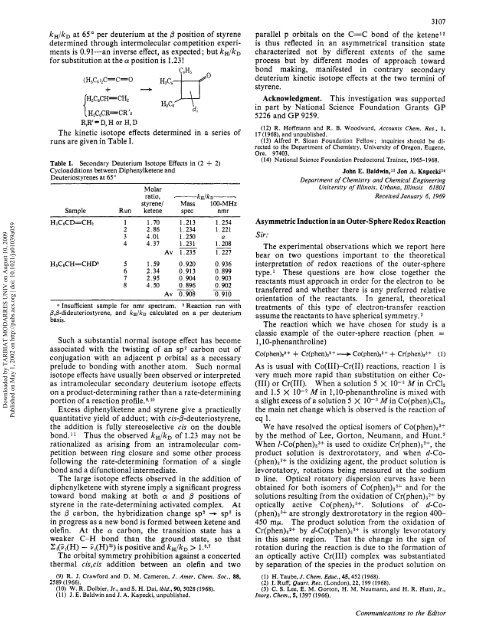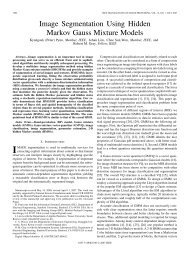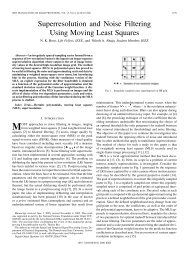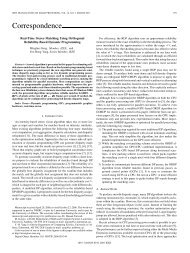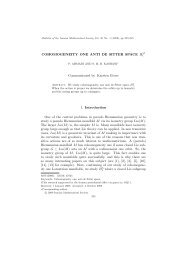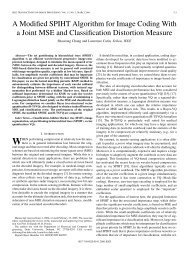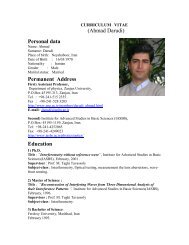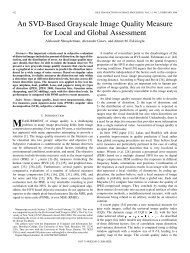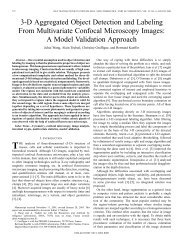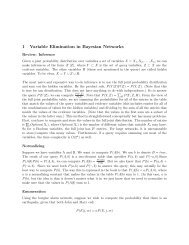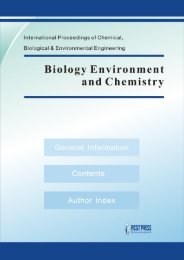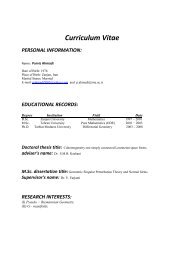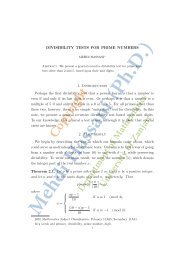Kinetic isotope effects on the (2+2) cycloadditions of diphenylketene ...
Kinetic isotope effects on the (2+2) cycloadditions of diphenylketene ...
Kinetic isotope effects on the (2+2) cycloadditions of diphenylketene ...
You also want an ePaper? Increase the reach of your titles
YUMPU automatically turns print PDFs into web optimized ePapers that Google loves.
Downloaded by TARBIAT MODARRES UNIV <strong>on</strong> August 10, 2009<br />
Published <strong>on</strong> May 1, 2002 <strong>on</strong> http://pubs.acs.org | doi: 10.1021/ja01039a059<br />
kH/kD at 65" per deuterium at <strong>the</strong> P positi<strong>on</strong> <strong>of</strong> styrene<br />
determined through intermolecular competiti<strong>on</strong> experiments<br />
is 0.91-an inverse effect, as expected; but kH/kD<br />
for substituti<strong>on</strong> at <strong>the</strong> a positi<strong>on</strong> is 1.23!<br />
(H,C,$=C=O<br />
+ 3<br />
H~CGCH-CHZ<br />
{ H,C6CR=CR'2<br />
CGHj<br />
R,R'= D, H or H, D<br />
The kinetic <str<strong>on</strong>g>isotope</str<strong>on</strong>g> <str<strong>on</strong>g>effects</str<strong>on</strong>g> determined in a series <strong>of</strong><br />
runs are given in Table I.<br />
Table I. Sec<strong>on</strong>dary Deuterium Isotope Effects in (2 + 2)<br />
Cycloadditi<strong>on</strong>s between Diphenylketene and<br />
Deuteriostyrenes at 65"<br />
-~<br />
0<br />
~ ~~~~ ~~<br />
Molar<br />
ratio, -----kH/kD----<br />
styrene/ Mass 100-MHz<br />
Sample Run ketene spec nmr<br />
HjCsCD=CHz 1 1.70<br />
2 2.86<br />
3 4.01<br />
4 4.37<br />
HF,C~CH=CHD* 5 1.59<br />
6 2.34<br />
7 2.95<br />
8 4.50<br />
Av<br />
Av<br />
1.213<br />
1,234<br />
1.250<br />
1.231<br />
1.235<br />
0.920<br />
0.913<br />
0.904<br />
- 0.896<br />
0.908<br />
-<br />
~ ~~ ~~ ~<br />
1.254<br />
1.221<br />
a<br />
1.208<br />
1.227<br />
-<br />
0.936<br />
0.899<br />
0.903<br />
- 0.902<br />
0.910<br />
_ _<br />
Insufficient sample for nrnr spectrum. *Reacti<strong>on</strong> run with<br />
P,P-dideuteriostyrene, and ka/kD calculated <strong>on</strong> a per deuterium<br />
basis.<br />
Such a substantial normal <str<strong>on</strong>g>isotope</str<strong>on</strong>g> effect has become<br />
associated with <strong>the</strong> twisting <strong>of</strong> an sp2 carb<strong>on</strong> out <strong>of</strong><br />
c<strong>on</strong>jugati<strong>on</strong> with an adjacent p orbital as a necessary<br />
prelude to b<strong>on</strong>ding with ano<strong>the</strong>r atom. Such normal<br />
<str<strong>on</strong>g>isotope</str<strong>on</strong>g> <str<strong>on</strong>g>effects</str<strong>on</strong>g> have usually been observed or interpreted<br />
as intramolecular sec<strong>on</strong>dary deuterium <str<strong>on</strong>g>isotope</str<strong>on</strong>g> <str<strong>on</strong>g>effects</str<strong>on</strong>g><br />
<strong>on</strong> a product-determining ra<strong>the</strong>r than a rate-determining<br />
porti<strong>on</strong> <strong>of</strong> a reacti<strong>on</strong> pr~file.~n~O<br />
Excess <strong>diphenylketene</strong> and styrene give a practically<br />
quantitative yield <strong>of</strong> adduct; with cis-P-deuteriostyrene,<br />
<strong>the</strong> additi<strong>on</strong> is fully stereoselective cis <strong>on</strong> <strong>the</strong> double<br />
b<strong>on</strong>d." Thus <strong>the</strong> observed kH/kD <strong>of</strong> 1.23 may not be<br />
rati<strong>on</strong>alized as arising from an intramolecular com-<br />
petiti<strong>on</strong> between ring closure and some o<strong>the</strong>r process<br />
following <strong>the</strong> rate-determining formati<strong>on</strong> <strong>of</strong> a single<br />
b<strong>on</strong>d and a difuncti<strong>on</strong>al intermediate.<br />
The large <str<strong>on</strong>g>isotope</str<strong>on</strong>g> <str<strong>on</strong>g>effects</str<strong>on</strong>g> observed in <strong>the</strong> additi<strong>on</strong> <strong>of</strong><br />
<strong>diphenylketene</strong> with styrene imply a significant progress<br />
toward b<strong>on</strong>d making at both a and positi<strong>on</strong>s <strong>of</strong><br />
styrene in <strong>the</strong> rate-determining activated complex. At<br />
<strong>the</strong> /3 carb<strong>on</strong>, <strong>the</strong> hybridizati<strong>on</strong> change sp2 + sp3 is<br />
in progress as a new b<strong>on</strong>d is formed between ketene and<br />
olefin. At <strong>the</strong> a carb<strong>on</strong>, <strong>the</strong> transiti<strong>on</strong> state has a<br />
weaker C-H b<strong>on</strong>d than <strong>the</strong> ground state, so that<br />
Llt(Yi(H) - 5,(H)*) is positive and kH/kD > l.6p7<br />
The orbital symmetry prohibiti<strong>on</strong> against a c<strong>on</strong>certed<br />
<strong>the</strong>rmal cis,cis additi<strong>on</strong> between an olefin and two<br />
(9) R. J. Crawford and D. M. Camer<strong>on</strong>, J. Amer. Chem. SOC., 88,<br />
2589 (1966).<br />
(10) W. R. Dolbier, Jr., and S. H. Dai, ibid., 90,5028 (1968).<br />
(1 1) J. E. Baldwin and J. A. Kapecki, unpublished.<br />
3107<br />
parallel p orbitals <strong>on</strong> <strong>the</strong> C=C b<strong>on</strong>d <strong>of</strong> <strong>the</strong> ketene12<br />
is thus reflected in an asymmetrical transiti<strong>on</strong> state<br />
characterized not by different extents <strong>of</strong> <strong>the</strong> same<br />
process but by different modes <strong>of</strong> approach toward<br />
b<strong>on</strong>d making, manifested in c<strong>on</strong>trary sec<strong>on</strong>dary<br />
deuterium kinetic <str<strong>on</strong>g>isotope</str<strong>on</strong>g> <str<strong>on</strong>g>effects</str<strong>on</strong>g> at <strong>the</strong> two termini <strong>of</strong><br />
styrene.<br />
Acknowledgment. This investigati<strong>on</strong> was supported<br />
in part by Nati<strong>on</strong>al Science Foundati<strong>on</strong> Grants GP<br />
5226 and GP 9259.<br />
(12) R. H<strong>of</strong>fmann and R. B. Woodward, Accounts Chem. Res,, 1.<br />
17 (1968), and unpublished.<br />
(13) Alfred P. Sloan Foundati<strong>on</strong> Fellow; inquiries should be di-<br />
rected to <strong>the</strong> Department <strong>of</strong> Chemistry, University <strong>of</strong> Oreg<strong>on</strong>, Eugene,<br />
Ore. 97403.<br />
(14) Nati<strong>on</strong>al Science Foundati<strong>on</strong> Predoctoral Trainee, 1965-1968.<br />
John E. Baldwin,I3 J<strong>on</strong> A. Kapeckil4<br />
Department <strong>of</strong> Chemistry and Chemical Engineering<br />
Utiicersity <strong>of</strong> Illiiiois, Urbana, Illinois 61801<br />
Receiced January 6, 1969<br />
Asymmetric Inducti<strong>on</strong> in an Outer-Sphere Redox Reacti<strong>on</strong><br />
Sir:<br />
The experimental observati<strong>on</strong>s which we report here<br />
bear <strong>on</strong> two questi<strong>on</strong>s important to <strong>the</strong> <strong>the</strong>oretical<br />
interpretati<strong>on</strong> <strong>of</strong> redox reacti<strong>on</strong>s <strong>of</strong> <strong>the</strong> outer-sphere<br />
type.' These questi<strong>on</strong>s are how close toge<strong>the</strong>r <strong>the</strong><br />
reactants must approach in order for <strong>the</strong> electr<strong>on</strong> to be<br />
transferred and whe<strong>the</strong>r <strong>the</strong>re is any preferred relative<br />
orientati<strong>on</strong> <strong>of</strong> <strong>the</strong> reactants. In general, <strong>the</strong>oretical<br />
treatments <strong>of</strong> this type <strong>of</strong> electr<strong>on</strong>-transfer reacti<strong>on</strong><br />
assume <strong>the</strong> reactants to have spherical symmetry.<br />
The reacti<strong>on</strong> which we have chosen for study is a<br />
classic example <strong>of</strong> <strong>the</strong> outer-sphere reacti<strong>on</strong> (phen =<br />
1,lO-phenanthroline)<br />
Co(phen)aaf + Cr(~hen)~2+ -+- C0(phen)~2+ + Cr(~hen)~3+ (1)<br />
As is usual with Co(II1)-Cr(I1) reacti<strong>on</strong>s, reacti<strong>on</strong> 1 is<br />
very much more rapid than substituti<strong>on</strong> <strong>on</strong> ei<strong>the</strong>r Co-<br />
(111) or Cr(II1). When a soluti<strong>on</strong> 5 X M in CrClz<br />
and 1.5 X Min 1,lO-phenanthroline is mixed with<br />
a slight excess <strong>of</strong> a soluti<strong>on</strong> 5 X Min C~(phen)~Cl~,<br />
<strong>the</strong> main net change which is observed is <strong>the</strong> reacti<strong>on</strong> <strong>of</strong><br />
eq 1.<br />
We have resolved <strong>the</strong> optical isomers <strong>of</strong> C~(phen)~~+<br />
by <strong>the</strong> method <strong>of</strong> Lee, Gort<strong>on</strong>, Neumann, and Hunt.3<br />
When I-C~(phen)~~+ is used to oxidize Cr(phen)32+, <strong>the</strong><br />
product soluti<strong>on</strong> is dextrorotatory, and when d-Cohen)^^+<br />
is <strong>the</strong> oxidizing agent, <strong>the</strong> product soluti<strong>on</strong> is<br />
levorotatory, rotati<strong>on</strong>s being measured at <strong>the</strong> sodium<br />
D line. Optical rotatory dispersi<strong>on</strong> curves have been<br />
obtained for both isomers <strong>of</strong> C~(phen)~~+ and for <strong>the</strong><br />
soluti<strong>on</strong>s resulting from <strong>the</strong> oxidati<strong>on</strong> <strong>of</strong> Cr(phen)a2+ by<br />
optically active C~(phen)~~+. Soluti<strong>on</strong>s <strong>of</strong> d-Cohen)^^+<br />
are str<strong>on</strong>gly dextrorotatory in <strong>the</strong> regi<strong>on</strong> 400-<br />
450 mp. The product soluti<strong>on</strong> from <strong>the</strong> oxidati<strong>on</strong> <strong>of</strong><br />
Cr(phen)32+ by d-C~(phen)~~+ is str<strong>on</strong>gly levorotatory<br />
in this same regi<strong>on</strong>. That <strong>the</strong> change in <strong>the</strong> sign <strong>of</strong><br />
rotati<strong>on</strong> during <strong>the</strong> reacti<strong>on</strong> is due to <strong>the</strong> formati<strong>on</strong> <strong>of</strong><br />
an optically active Cr(II1) complex was substantiated<br />
by separati<strong>on</strong> <strong>of</strong> <strong>the</strong> species in <strong>the</strong> product soluti<strong>on</strong> <strong>on</strong><br />
(1) H. Taube,J. Chem. Educ., 45,452 (1968).<br />
(2) I. Ruff, Quart. Reo. (L<strong>on</strong>d<strong>on</strong>), 22, 199 (1968).<br />
(3) C. S. Lee, E. M. Gort<strong>on</strong>, H. M. Neumann, and H. R. Hunt, Jr.,<br />
Inorg. Chem., 5, 1397 (1966).<br />
Communicati<strong>on</strong>s to <strong>the</strong> Editor


